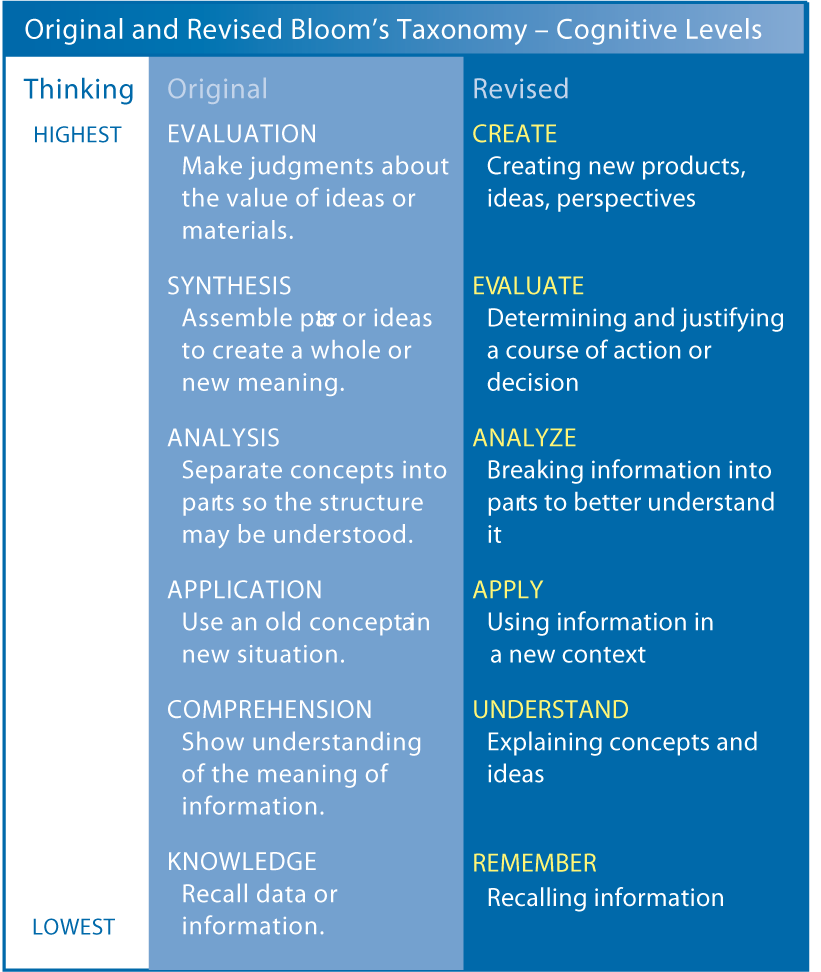Moving up Bloom's Taxonomy
Develop higher-order thinking skills and engage students with technology tools

It’s difficult to think about doing creative, authentic projects with students when the school is consumed with test prep fever and the state tests are just a week away. Testing has, indeed, had a tremendous impact on curriculum and instruction in our schools.
While tests give us benchmark data on where students are with knowledge and skill development, they often fall short of helping students develop the higher level thinking skills that 21st century students need for a technological workplace.
Creative projects, on the other hand, almost always engage students in analytical and evaluative thinking. They are not about giving the right answer; rather, they are all about extending information to find solutions or develop new ideas.
Over 50 years ago, Benjamin Bloom and his colleagues developed a framework for determining the extent to which objectives and activities engaged students in higher-level thinking. Known as Bloom’s Taxonomy, it became the standard for educators to use in creating activities that use higher-level skills. Bloom’s taxonomy covered three areas: cognitive (mental development), affective (attitude), and psychomotor (physical skills). The cognitive taxonomy relates to helping students learn content and skills to solve problems.
Within the past few years, David Krathwhol, who was on the original Bloom project, met with others to update the taxonomy. A comparison of the original and revised taxonomies appears below. In the revised taxonomy, the categories have changed from nouns to verbs, reflecting teacher and student actions. Some categories have also been changed, such as evaluate moving to a lower place on the taxonomy, to show a more logical progression of thought.
As teachers, we need to be aware of the level of thought of activities so we can be assured that we are providing a variety of experiences for our students and helping them develop higher levels of thinking. It is important to remember, though, that students can’t just jump to creating complex products and ideas (the highest level) if they haven’t mastered some lower level skills such as remembering and understanding. If students don’t remember or understand the information they are studying, they are unlikely to be able to apply it in a new situation or analyze and evaluate it to develop products or ideas.
Implementing Technology Projects that Develop Higher Level Thinking
Let’s take a look at some typical topics that are covered in the classroom. Starting with a traditional approach to teaching these topics, let’s see how the revised Bloom’s Taxonomy might illustrate how higher levels of thinking are promoted.

After reading a story about the farm, students traditionally write a fact about an animal (Remember) and draw a picture to illustrate to show the fact (Understand). In the Let’s Go To the Farm! lesson, students use Pixie or Wixie to create a class Web site about farm animals. This Web site will provide information about what each farm animal eats, the animal’s job on the farm, the sound the farm animal makes, and a picture of the animal. While this lesson certainly includes the same lower level thinking skills a traditional approach uses, it also requires students to analyze the material, make decisions, and create an end product that showed understanding.

Historical Figures
After watching a movie about a historical figure, such as Martin Luther King, Jr., students traditionally write a report about his life using facts they have learned (Remember) to show comprehension (Understand). In the Design a New Dollar Coin lesson, students use their visual skills and Wixie to create a coin design that represents the work of a person who impacted history and write persuasively about why this person should be honored on this new dollar coin. While the first activity could have merit and might be aligned with standards, it does not have the higher level of thought that this coin project has.

Angles
In a traditional classroom, the teacher shows a series of angles in pictures of real objects and students name (Remember) the type of angle shown (Understand). In the Angles all Around lesson, students use a digital camera to identify and capture their own examples of different types of angles they find around their school. They use Pixie or Wixie to identify the type of angle by painting on the image.

In the hands of a good teacher, the traditional examples could also involve some levels of analyzing and evaluating, but these higher level processes are not inherent in the activities. Projects work because students must engage in higher thought to develop an end-product of quality.
A Quick Strategy for Assessing the Level of Activities
Not all lessons or projects involve all levels of Bloom’s. That’s fine, because to engage students in very involved projects all the time would take more classroom time than most teachers have. There is a time and place for more didactic, lower level lessons.
A quick way to check on the level of the lesson is to answer these two questions.
- What will the students (not the teacher) be doing in this lesson, recalling and showing understanding (lower) or analyzing and evaluating to create a product (higher)?
- Will students be expected to respond with specific, known answers (lower) or will they be asked to generate original thought (higher)?
The answers will give us a snapshot of the levels of thought in our lessons. If students are predominately responding with the right answer and are demonstrating that they understand a concept, then the lesson is lower level. If the lesson’s objective is to show that students comprehend the material, then lower level activities are appropriate. On the other hand, if the objective is to extend basic knowledge and apply it to new situations to develop a new product or idea, then the response to the two questions should reflect higher level thought.
One way teachers can get an overview of the Bloom level is to review their plan book over the course of a typical week. After asking the two questions above about each lesson, they can mark the lesson either L (low level) or H (high level). Looking over the course of a week or longer will reveal a pattern of lower and higher level activities. It is up to the teacher to decide if the balance is appropriate.
The bottom line on all of our teaching is to have students learn, not just for “the test” but for successful performance throughout life. A good balance of lower and higher level experiences will help students develop a solid background of content and skills as well as the analytical and evaluative tools to apply them. Creative projects are a proven way to engage students at higher levels. By using projects in balance with content and skill development activities, we will be preparing our students well for the future.
References
Anderson, L. W., & Krathwohl, D. R. (Eds.). (2001). A taxonomy for learning, teaching and assessing: A revision of Bloom’s Taxonomy of educational objectives: Complete edition. New York, Longman.
Bloom, B. S. & Krathwohl, D. R. (Eds.) (1956). Taxonomy of educational objectives: The classification of educational goals, by a committee of college and university examiners. Handbook 1: Cognitive domain. New York, Longman.














